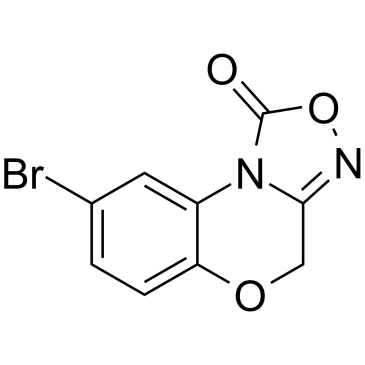NS-2028

NS-2028 structure
|
Common Name | NS-2028 | ||
|---|---|---|---|---|
| CAS Number | 204326-43-2 | Molecular Weight | 269.052 | |
| Density | 2.1±0.1 g/cm3 | Boiling Point | 353.8±52.0 °C at 760 mmHg | |
| Molecular Formula | C9H5BrN2O3 | Melting Point | 161-162ºC | |
| MSDS | USA | Flash Point | 167.8±30.7 °C | |
Use of NS-2028NS-2028 is a highly selective soluble Guanylyl Cyclase (sGC) inhibitor with IC50 values of 30 nM and 200 nM for basal and NO-stimulated enzyme activity[1]. NS-2028 inhibits soluble Guanylyl Cyclase activity in homogenates of mouse cerebellum and neuronal NO synthase with IC50 values of 17 nM and 20 nM[1]. NS-2028 inhibits 3-morpholino-sydnonimine (SIN-1)-elicited formation of cyclic GMP in human cultured umbilical vein endothelial cells with an IC50 of 30 nM[1]. NS-2028 is commonly used in the research of nitric oxide signaling pathways, it inhibits NO-dependent relaxant responses in non-vascular smooth muscle completely (1 μM)[1]. NS-2028 reduces vascular endothelial growth factor-induced angiogenesis and permeability[2]. |
| Name | 4h-8-bromo-1,2,4-oxadiazolo(3,4-d)benz(b)(1,4)oxazin-1-one |
|---|---|
| Synonym | More Synonyms |
| Description | NS-2028 is a highly selective soluble Guanylyl Cyclase (sGC) inhibitor with IC50 values of 30 nM and 200 nM for basal and NO-stimulated enzyme activity[1]. NS-2028 inhibits soluble Guanylyl Cyclase activity in homogenates of mouse cerebellum and neuronal NO synthase with IC50 values of 17 nM and 20 nM[1]. NS-2028 inhibits 3-morpholino-sydnonimine (SIN-1)-elicited formation of cyclic GMP in human cultured umbilical vein endothelial cells with an IC50 of 30 nM[1]. NS-2028 is commonly used in the research of nitric oxide signaling pathways, it inhibits NO-dependent relaxant responses in non-vascular smooth muscle completely (1 μM)[1]. NS-2028 reduces vascular endothelial growth factor-induced angiogenesis and permeability[2]. |
|---|---|
| Related Catalog | |
| Target |
IC50: 30 nM (soluble Guanylyl Cyclase sGC)[1] |
| In Vitro | NS-2028 (10 μM; 24 hours) inhibits 25% cell number in comparation with those grown in the presence of vehicle[2]. NS-2028 (10 μM; 30 mins) attenuates VEGF-induced EC migration by inhibiting p38 MAPK activation[2]. Cell Proliferation Assay[2] Cell Line: HUVEC cells Concentration: 10 μM Incubation Time: 24 hours Result: Decreased cell numbers in culture. Western Blot Analysis[2] Cell Line: HUVEC cells Concentration: 10 μM Incubation Time: 30 mins Result: Attenuated VEGF-enhanced p38 phosphorylation. |
| In Vivo | NS-2028 (Deliver orally; 1 g/L; 8 days) exhibits a significant reduction of new vessel formation in the avascular rabbit cornea in response to VEGF pellet implants[2]. Animal Model: Rabbit[2] Dosage: 1 g/L Administration: Deliver orally; 1g/L; 8 days Result: Inhibits VEGF-induced angiogenesis in vivo. |
| References |
| Density | 2.1±0.1 g/cm3 |
|---|---|
| Boiling Point | 353.8±52.0 °C at 760 mmHg |
| Melting Point | 161-162ºC |
| Molecular Formula | C9H5BrN2O3 |
| Molecular Weight | 269.052 |
| Flash Point | 167.8±30.7 °C |
| Exact Mass | 267.948334 |
| PSA | 57.26000 |
| LogP | 0.27 |
| Vapour Pressure | 0.0±0.8 mmHg at 25°C |
| Index of Refraction | 1.778 |
| InChIKey | MUDRLQRJCGJJTB-UHFFFAOYSA-N |
| SMILES | O=c1onc2n1-c1cc(Br)ccc1OC2 |
| Personal Protective Equipment | Eyeshields;Gloves;type N95 (US);type P1 (EN143) respirator filter |
|---|---|
| Hazard Codes | Xi |
| RIDADR | NONH for all modes of transport |
|
Contribution of nitric oxide-dependent guanylate cyclase and reactive oxygen species signaling pathways to desensitization of μ-opioid receptors in the rat locus coeruleus.
Neuropharmacology 99 , 422-31, (2015) Nitric oxide (NO) is involved in desensitization of μ-opioid receptors (MOR). We used extracellular recordings in vitro to unmask the NO-dependent pathways involved in MOR desensitization in the rat l... |
|
|
Characterization of NS 2028 as a specific inhibitor of soluble guanylyl cyclase.
Br. J. Pharmacol. 123 , 299-309, (1998) 1 The haeme-containing soluble guanylyl cyclase (alpha1beta1-heterodimer) is a major intracellular receptor and effector for nitric oxide (NO) and carbon monoxide (CO) and mediates many of their biolo... |
| 4H-8-BROMO-1,2,4-OXADIAZOLO(3,4-D)BENZO(B)(1,4)OXAZIN-1-ONE |
| 8-BROMO-4H-2,5-DIOXA-3,9B-DIAZA CYCLOPENTA[A]NAPHTHALEN-1-ONE |
| Kartogenin |
| 4H-8-Bromo-1,2,4-oxadiazolo[3,4-d]benz[b][1,4]oxazin-1-one |
| NS-2028 |
| 1H,4H-[1,2,4]Oxadiazolo[3,4-c][1,4]benzoxazin-1-one, 8-bromo- |
| 8-Bromo-4H-[1,2,4]oxadiazolo[3,4-c][1,4]benzoxazin-1-one |